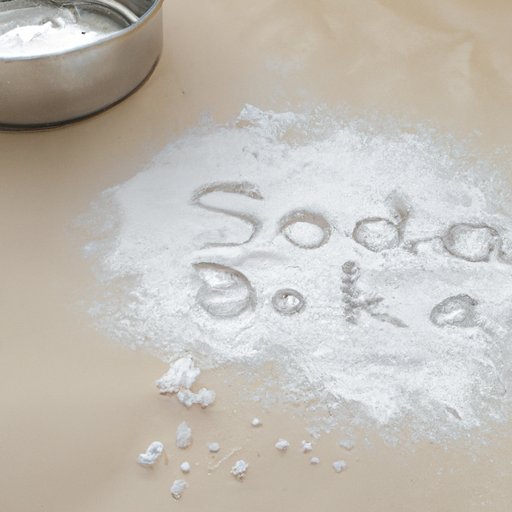I. Introduction
There’s nothing worse than getting ready to bake a delicious treat and realizing you’ve run out of baking powder. But fear not! Baking soda can be a great substitution when you’re in a pinch. In this article, we’ll provide a complete guide to using baking soda as a substitute for baking powder so you can keep on baking without any hiccups.
II. Baking Soda for Baking Powder: The Ultimate Substitution Guide
Baking soda and baking powder might seem like two interchangeable ingredients, but they actually serve very different purposes in baking. Put simply, baking powder includes baking soda, but it also involves an acidic component that creates a reaction when mixed with a liquid. This reaction causes bubbles to rise in the pastry, resulting in a fluffy texture. Baking soda, on the other hand, is more powerful since it doesn’t include the acid component and only reacts when combined with acidic ingredients such as vinegar or lemon juice. When baking, it’s important to know when to use what ingredient to achieve your desired texture.
III. Can’t Find Baking Powder? No Problem! Here’s How to Use Baking Soda Instead
If you’re in a pinch and can’t find baking powder at your local grocery store, try looking in specialty stores or online. If that’s not an option, don’t fret. There are alternatives you can use such as cream of tartar or homemade baking powder (a mixture of baking soda, cream of tartar, and cornstarch). When you do decide to use baking soda as a substitute, remember that it’s much more powerful, so adjust the amount accordingly. For instance, if a recipe calls for 1 tsp of baking powder, you should only use ¼ tsp of baking soda. You can enhance your substitute by adding an acidic component to your recipe, such as yogurt or sour cream, for a fluffy texture.
IV. How to Bake Perfect Treats with Baking Soda When You’re Out of Baking Powder
There are certain baking techniques specific to using baking soda as a substitute for baking powder that may help you achieve the texture you want. For example, you can mix baking soda into the flour to create a lighter texture for a pastry, or you can add it to a wet mixture if you’d like a denser or chewier texture. Be sure to pay attention to the recipe and adjust your baking techniques accordingly. Common pitfalls to avoid when using baking soda include overusing it, which creates a bitter taste, or not adding enough of an acidic component to your recipe, resulting in a dense texture. We recommend testing your recipe with small batches initially so that you can make alterations before baking a full batch. Below are a few recipes that are great for practicing your baking soda substitution skills.
V. The Science behind Substituting Baking Soda for Baking Powder
When it comes to baking, science plays a critical role in the end result. Understanding the chemical reactions that occur during baking can help you understand why a recipe calls for certain ingredients. There are two types of baking powder regularly used in baking: single-acting and double-acting. Single-acting baking powder reacts when it comes in contact with moisture. Double-acting reacts twice, once when it becomes moist and a second time when it heats up. Baking soda, on the other hand, is an alkaline substance and reacts with acidic substances to create carbon dioxide. It’s important to remember that these ingredients have fundamental differences, so you should be cautious when substituting them for one another.
VI. 5 Easy Recipes Where You Can Use Baking Soda Instead of Baking Powder
Substituting baking soda for baking powder can be tricky, but it’s not impossible. The following recipes are delicious and require only basic ingredients, making them perfect for practicing your baking soda skills:
- Pancakes: Add some yogurt or buttermilk to the recipe to create a fluffier texture.
- Chocolate cake: Balance the bitterness of baking soda with acidic ingredients such as sour cream.
- Brownies: Replace baking powder with cream of tartar for a crumbly and chewy texture.
- Banana bread: Add mashed bananas to the mixture to enhance the rising properties of the baking soda.
- Drop cookies: Utilize baking soda for an airy and soft texture.
VII. Baking Powder vs. Baking Soda: When Can You Use One for the Other?
Although baking soda can substitute for baking powder, there are instances when it’s not recommended. For instance, if the recipe calls for a specific type of baking powder such as double-acting, the substitution might not be successful. The chemistry of the two ingredients is different, and recipes that solely rely on baking powder might not rise as effectively with baking soda. For example, in angel food cake, baking powder is replaced with cream of tartar which gives the cake its spongy, airy texture. While in some instances you can use one for the other, always pay attention to the recipe to determine if a substitution will be successful.
VIII. Conclusion
Substituting baking soda for baking powder can be an easy solution if you’re in a pinch, but it’s critical to understand the science behind substituting these ingredients. As with all things in baking, practice makes perfect, so don’t be intimidated and give it a try.
